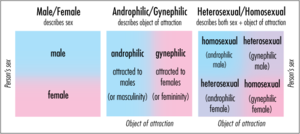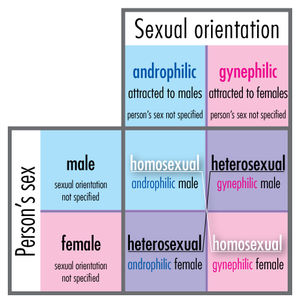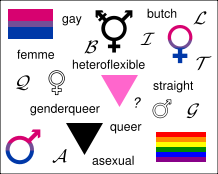What is homosexuality?
 Image via Wikipedia
Image via Wikipedia Image via Wikipedia
Image via Wikipedia Image via Wikipedia
Image via Wikipedia Image via Wikipedia
Image via Wikipedia Image via Wikipedia
Image via WikipediaFirst of all, the word “homosexuality” is a fairly recent term that originated within modern Western culture in the fields of medicine, psychiatry and psychology. Prior to the 19th century, most people understood male/male or female/female sexual intimacy from a behavioral point of view. Individuals who engaged in it were not thought to be essentially different from those who didn’t; but their actions were deemed to be sinful, or even criminal.
In the 1800s, these ideas began to shift toward a consideration of the nature of the people involved. This continued on into the next century as an emphasis on individual sexuality emerged and proliferated. Sex was no longer viewed simply as an activity that people engaged in but as a real, central and indispensable dimension of the self.
The word homosexuality itself was first used by a German psychologist in 1869 to describe a form of mental illness. By the end of the century, it began to enter the public sphere as a description of deviant or pathological sexual desire and behavior. But when a prominent study in the 1950s found no basic psychological differences between homosexual and heterosexual men, many professionals began to question the idea of pathology. As a result, the American Psychiatric Association removed homosexuality from its official listing of mental disorders in 1973. And with the rise of the gay rights movement in the late 60s and early 70s, “gay,” “lesbian,” and “straight” also became popular terms.
So, when the word “homosexuality” is used today, it might mean several different things:
- same sex or same gender attraction
- sexual orientation
- sexual identity
The three concepts are interrelated, but they are not the same.
Same-sex attraction (SSA) or same-gender attraction (SGA) are terms that simply acknowledge the fact that some men and women experience sexual attraction for people of their same sex or gender.
Sexual orientation takes it a step further; when attractions persist, they are viewed as “inclinations” or “predispositions,” or they’re even considered to be a permanent part of one’s essential constitution or being. In its online website, the American Psychological Association describes sexual orientation as “an enduring pattern of emotional, romantic, and/or sexual attractions to men, women or both sexes.” Even though many professionals acknowledge there is no real consensus about the meaning of “sexual orientation,” most people typically think of it in these three categories:
- heterosexual – attracted exclusively or primarily to the opposite sex
- homosexual – attracted exclusively or primarily to the same sex, or
- bisexual – attracted almost equally to both sexes.
When an individual adopts the label “gay” or “lesbian,” that enters the realm of sexual identity. Identity can be expressed personally, as in “I am my sexuality” or “my sexuality describes and defines my being.” And it can also be expressed communally by affiliating with a homosexual subculture for sexual and sociopolitical purposes.
The terms “sexual identity” and “sexual orientation” are often used interchangeably, but a number of professionals have argued that a distinction should be made between the two, and between them and same-sex attraction. National polls appear to support their position; when surveyed, greater numbers of people report SSA than they do a homosexual orientation. And not everyone who experiences SSA or a homosexual orientation goes on to identify as gay or lesbian.
It also makes sense when you realize that human beings don’t fit so neatly into simplistic sexual categories and boxes. One size really doesn’t fit all. There are marked gender differences, for example, with women’s sexuality observed to be much more fluid than men’s. Likewise, behavioral choices vary over time, or due to circumstance, or because of ethnic background. Youth and young adults may experiment with homosexuality or bisexuality for a season because they’re curious or it’s the trendy or politically correct thing to do. Prisoners may engage temporarily in “environmental” homosexuality when there are no opposite sex partners available. Committed feminists may embrace lesbianism as a form of political and personal resistance and later repudiate that decision. African-American men may have male-on-male sex secretly, “on the down low,” while still considering themselves to be “straight.”
Finally, Christians ought to seriously consider how our careless use of any of these labels or categories confuses the language of faith. In an online essay entitled “The Church and Homosexuality,” United Methodist Bishop Timothy Whitaker raised some thought-provoking concerns. He suggested it might be more fitting for the Church to speak of someone as experiencing same-sex attraction than to refer to him or her as homosexual, gay or lesbian. Reminding his readers that the Church has always viewed Christian identity in terms of our relationship to God, he concluded that “once the church succumbs to the idea that our basic identity is sexual rather than theological in nature, then the church has already lost its way in the discussion.”*
*Timothy Whitaker, “The Church and Homosexuality,” July 13, 2006. Posted on the Florida Annual Conferencewebsite. Whitaker is the United Methodist resident Bishop of the Florida area.


